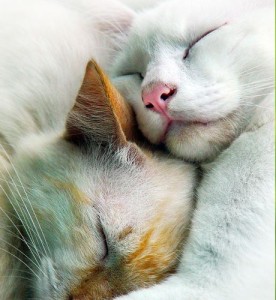Everything You Never Knew You Never Knew About Sleep!
Sleep. It’s something we all do, an important part of our lives from the very beginning, and every single day. We might think we know about sleep, because we have gotten very good at it over the years, but here are a few facts about sleep that may surprise you. Take note, this information may come in handy if you’re ever a contestant on Jeopardy!
- The word “sleep” comes from the Proto-European base word “sleb” meaning “to be weak.”
- Most of what we know about sleep science has come about in just the last 25 years.
- Sleep is a characteristic of complex living beings including insects, mollusks, fish, amphibians, birds, and mammals.
- Among animals, the giraffe sleeps the least amount, fewer than 2 hours a day in five to ten minute intervals. The koala sleeps the most, up to 22 hours a day. Cats sleep an average of 12 hours a day, and dogs sleep about 10 ½ hours a day – this is in addition to nighttime sleep.
- The dolphin’s brain is unique in that one half of it sleeps at a time. This is called “unihemispheric sleep” – where one hemisphere of the brain is awake while the other hemisphere sleeps. Because of this, dolphins can sleep under water without drowning. Like humans, dolphins spend about one third of their lives asleep.
- A “catnap” is a short sleep, usually not in bed. People can take catnaps with their eyes open and not even know it.
- People typically dream four to six dreams per night, lasting a combined total of more than two hours. This adds up to about six years of dreaming.
- Upon waking, half of a dream is forgotten in the first five minutes. When ten minutes has gone by we have forgotten 90% of it. Although 42% of people say they have had a dream about something that later came true.
- 12% of people only have dreams in black and white.
- There are at least 84 identified sleep/wake disorders.
- More than 70 million people in the USA suffer from a sleep disorder. Of those, more than 60% have a chronic sleep disorder.
- People can survive longer without food than we can without sleep.
- Modern society has such high numbers of sleep deprivation that what is really abnormal sleepiness is now considered normal.
- Sleep deprivation, when applied systematically, is said to be the most effective form of torture. One reason is that sleep deprivation causes the body to produce higher levels of the stress hormone corticosterone.
- Somnambulism is the scientific word for sleepwalking. Even though they can talk, walk, and even eat while asleep, most sleepwalkers don’t remember much about their experiences. Scientists believe that sleepwalking has a genetic component.
- When one partner snores, he or she wakes his non-snoring partner 20 times a night on average, with a sleep loss of about one hour a night.
- Snoring usually worsens after drinking alcohol. Alcohol has a depressant effect on the tongue and throat muscles, narrowing the upper airway space.
- Brains are more active during sleep than while watching television. You also burn more calories sleeping than you do when watching television.
- Charles Dickens suffered from insomnia. He believed that he could fall asleep faster in the middle of a bed facing north.
- William Shakespeare often wrote about sleep in his plays. Scholars believe he gave such clear descriptions of insomnia because he suffered from the disorder. “We are such stuff as dreams are made on, and our little life is rounded with a sleep.” –The Tempest
- The saying “good night, sleep tight” came about when mattresses were set upon ropes woven through a bed frame. When the ropes started sagging, they were tightened with a bed key.
- The phrase “hit the sack” dates back to the 9th century when homes were one big room used for all activities. At the end of the day, families would clean up after dinner and make up a bed by putting hay in a sack.
- The largest bed ever constructed is the Great Bed of Ware in Great Britain. Built in 1596 it measured 11 feet by 11 feet and was said to sleep 12 comfortably.
- Waterbeds became all the rage in the 1970s, but they actually date back to the 19th century when they were available in hospitals. The water eliminated pressure points so they could be used to support patients with bone fractures, bedsores, or even paralysis.
Today we have more choices than ever in mattresses, materials, styles, and sizes! If you’re not getting either the quality or quantity of sleep that you need to feel great and be productive, check out the many options available. Like Goldilocks, you’re sure to find a bed that is “just right” for you! More info about all things sleep at BetterSleep.org
Sources:
“What You Never Knew About Beds, Bedrooms & Pajamas” by Patricia Lauber
“Counting Sheep: The Science and Pleasures of Sleep and Dreams” by Paul Martin
Online Etymology Dictionary
“Encyclopedia of Sleep and Sleep Disorders” by Michael Thorpy and Jan Yager

cats sleeping









